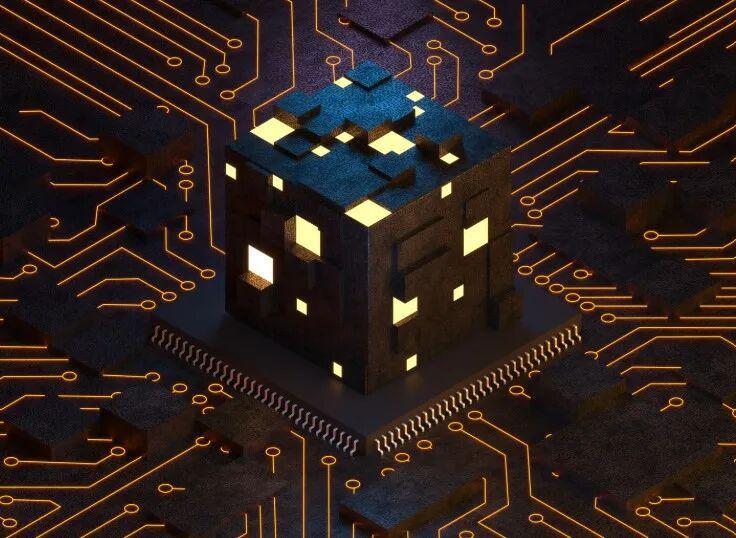AI is not lacking electricity, but time.
Author: Facing AI
It is said that the end of AI is energy. Microsoft CEO Satya Nadella recently indirectly confirmed this viewpoint in an interview. "Due to a lack of electricity, many of Microsoft's GPUs are lying idle in storage," Nadella stated.
Google recently came up with the innovative idea of sending TPUs into space to harness solar power for machine operation, seemingly echoing Nadella's statement.
However, it is strange that while Nadella's statement appears to benefit the energy sector, neither the A-shares nor the Nasdaq has seen an increase in their energy sectors as a result. From early November until the time of writing, A-shares have seen a 0% increase, and the largest energy company in the Nasdaq has only increased by 0.77%.
On one hand, Silicon Valley giants are lamenting the lack of electricity and even proposing solutions like "going to space," but on the other hand, the market seems to be ignoring such a clear signal and has not responded.
This raises a question: Is the AI industry really lacking electricity?
OpenAI CEO Sam Altman’s view is: Yes and no.
It is a yes because there is indeed a current shortage of electricity; it is a no because the essence of the problem is actually an oversupply of AI. Although he is unsure of the exact timeline, he believes that within a maximum of six years, AI will exceed people's needs, which will also lead to a decrease in AI's demand for electricity.
In other words, the AI industry may face short-term power outages, but in the long term, as AI energy consumption decreases, the electricity shortage issue will be resolved.
01
Google announced a project called "Project Suncatcher" in early November 2025, which operates by sending TPU chips into space to generate power from solar energy.

The energy radiated by the sun every second is approximately 3.86 times 10 to the power of 26 watts, which is over a trillion times the total global electricity generation of human society. Satellites deployed in a sun-synchronous orbit can almost continuously receive sunlight, and over a year, they can collect eight times the energy that solar panels of the same area would receive in mid-latitude regions on Earth.
The Suncatcher project collaborates with satellite company Planet Labs to deploy an AI computing cluster consisting of 81 satellites in low Earth orbit, 650 kilometers above the ground. According to the design, these satellites will work together in a space of one kilometer in radius, maintaining a distance of 100 to 200 meters from each other. The first two experimental satellites are expected to be launched in early 2027 to verify the feasibility of the plan.
Although Google has stated that it has reduced the energy consumption per query of its Gemini model by 33 times within a year, it is clear that Google still needs electricity.
Using solar power in space is not a new concept, but it has long been hindered by a core challenge: how to efficiently and safely transmit the generated electricity back to Earth. Whether using microwave beams or laser beams, energy loss during transmission and potential impacts on the ground environment have made large-scale implementation difficult.
The Suncatcher project circumvents this issue. It does not intend to send data back to Earth but rather to use the electricity directly in space for computation, only transmitting the results back to the ground.
The TPU supercomputer cluster on the ground uses customized low-latency optical chip interconnect technology, with each chip capable of achieving throughput of hundreds of gigabits per second (Gbps).
Currently, commercial inter-satellite optical communication links typically have data rates ranging from 1 to 100 Gbps, which is far from sufficient to meet the demands of large-scale data exchange within AI computing clusters. Google's proposed solution is to use dense wavelength division multiplexing technology, which theoretically could allow each inter-satellite link to achieve a total bandwidth of about 10 terabits per second (Tbps).
Google has explained many of the challenges and solutions regarding the Suncatcher project, such as how to control the cluster formation and how to resist radiation, etc.
But Google has not explained how to dissipate heat.
This is a very tricky physical problem; there is no air convection in a vacuum, and heat can only be dissipated through radiation. Google once mentioned in a paper that advanced thermal interface materials and heat transfer mechanisms are needed, preferably passive ones to ensure reliability, to efficiently conduct the heat generated by the chips to dedicated heat sink surfaces for radiation. However, the paper did not provide much detail on this technical aspect.
In fact, the idea of sending data centers into space is not unique to Google. Just days before Google announced its plan, a startup named Starcloud had already launched a satellite equipped with NVIDIA H100 chips, claiming to build a space-based data center with a power capacity of 5 gigawatts. Elon Musk has also stated that SpaceX "will do" space data centers.
In May 2025, the first 12 computing satellites of the "Trisolaris Computing Constellation," a collaboration between China's Zhijiang Laboratory and Guoxing Aerospace, were successfully launched and networked.
So, regarding the issue of sending AI to space, while it sounds novel, everyone's goal is the same: to use electricity, and if there isn't enough on the ground, they will go up there to get it.
02
The main reason for AI's electricity hunger can be attributed to NVIDIA. The company's GPU products have seen power consumption increase several times within just four years, from the Ampere architecture to the Blackwell architecture.
A server rack using Hopper architecture GPUs has a rated power of about 10 kilowatts; however, with the increase in the number of GPUs in the Blackwell architecture, the rack power approaches 120 kilowatts.
Moreover, since GPUs are now measured in tens of thousands, when tens of thousands of GPUs communicate with each other, they rely on NVIDIA's interconnect technology, NvLink, to enhance communication efficiency. Each NvLink connection consumes 4 to 6 watts, and there are 18 links between two GPUs, which must be aggregated to an NvSwitch for non-blocking connections, with each NvSwitch consuming 50 to 70 watts.
If a GPU cluster has 10,000 H100s, it would require 157 NvSwitches and 90,000 NvLink connections, resulting in a total power consumption of approximately 730 to 1,100 kilowatts.

Furthermore, GPUs are also significant consumers of electricity when it comes to heat dissipation. The most common 8-card H100 server, if using an air cooling system, has a power consumption of 150 watts, meaning that a cluster of 10,000 cards would require 187 kilowatts just for cooling.
Currently, the competition among large tech companies has shifted from traditional computing power metrics to energy consumption metrics measured in gigawatts (GW). Companies like OpenAI and Meta plan to increase their computing capacity by over 10 gigawatts in the coming years.
As a reference, the AI industry consumes 1 gigawatt of electricity, which is enough to supply the daily electricity needs of about 1 million American households. The International Energy Agency estimates in a report from 2025 that by 2030, energy consumption in the AI sector will double, with a growth rate nearly four times that of the grid itself.
Goldman Sachs predicts that by 2027, global data center electricity demand is expected to grow by 50%, reaching 92 gigawatts. The share of electricity demand from U.S. data centers in total electricity demand is projected to increase from 4% in 2023 to 10% by 2030. Additionally, Goldman Sachs pointed out that some large data center campuses have electricity access requests that can reach levels of 300 megawatts to several gigawatts for a single project.
However, an interesting observation arises.
NextEra Energy is the largest renewable energy company in North America, and the representative industry ETF tracking the performance of U.S. utility sectors is named XLU. Over the past 52 weeks, NextEra's increase has been 11.62%, and the ETF XLU has increased by 14.82%, while the S&P 500 index has risen by 19.89% during the same period.
If the AI industry is truly facing a severe electricity shortage, then energy companies and utility sectors, as electricity suppliers, should be receiving excess market returns, rather than underperforming the overall market.
In response, Nadella provided a key clue. He stated, "The approval process for grid access takes five years," and "the construction of transmission lines takes 10 to 17 years."
Meanwhile, the procurement cycle for GPUs is measured in quarters, the construction cycle for data centers typically takes 1 to 2 years, and the explosive demand for AI is changing on a quarterly basis.
These time scales differ by orders of magnitude, and the resulting time mismatch is the essence of Nadella's claim that AI lacks electricity.
Moreover, Nadella faces another current dilemma. In 2020, Microsoft announced its goal to "achieve carbon negativity, net water increase, and zero waste" while protecting ecosystems.
However, the reality is that nearly 60% of the electricity used by Microsoft data centers still comes from fossil fuels, including natural gas. The annual carbon dioxide emissions generated are roughly equivalent to the total emissions of 54,000 average American households.
On the other hand, the International Energy Agency's "Renewable Energy Report" released in October 2025 pointed out that the growth rate of global power generation capacity may exceed the new electricity demand, including that from AI.
The report suggested that during the five years from 2025 to 2030, global renewable energy installed capacity will increase by 4,600 gigawatts, which is roughly equivalent to the total installed capacity of the economies of China, the European Union, and Japan combined. Furthermore, the report predicts that the new installed capacity during these five years will be double that of the previous five years.
It is particularly important to mention nuclear energy. Nuclear energy is the only option that can provide stable, large-scale, low-carbon electricity. The problem with traditional large nuclear power plants is their long construction cycles, high costs, and significant risks. However, small modular reactors (SMRs) are changing this situation. SMRs can be mass-produced in factories like airplanes or cars, with standardized modules transported to the site for assembly, similar to a "Lego" construction method.
SMRs have a single unit capacity of only 50-300 megawatts, much smaller than traditional nuclear power plants, which range from 1,000 to 1,600 megawatts, but this is precisely their advantage. Smaller scale means shorter construction cycles, lower initial investments, and more flexible siting. SMRs can be mass-produced in factories and then assembled on-site, significantly reducing costs and risks.
SMRs are currently the hottest and trendiest power generation method. Google has signed an agreement with Kairos Power to purchase 500 megawatts of SMR nuclear power, marking the first direct investment in SMR technology by a tech company. Microsoft, in January 2024, hired a former nuclear strategy and project director from Ultra Safe Nuclear Corporation (USNC) to serve as Microsoft's nuclear technology director, aiming to develop SMRs and even smaller micro modular reactors (MMRs).
In other words, what Microsoft lacks is not electricity, but time.
03
In addition to energy, reducing the power consumption of AI itself is also an important development direction.
Altman's view is that the cost per unit of intelligence is decreasing by 40 times each year, and it is likely that in a few years, we will not need as much infrastructure. Moreover, if breakthroughs continue, personal-level general artificial intelligence may run on laptops, further reducing electricity demand.

Altman once wrote an article using his own product as an example to explain this issue. In the article, he mentioned that from the GPT-4 model at the beginning of 2023 to the GPT-4o model in mid-2024, in just one year, the cost per token decreased by approximately 150 times. With the computing power remaining constant, the electricity consumed for the same business at different stages of AI development will decrease.
He stated that such a significant price drop cannot be achieved solely through linear reductions in hardware costs; it must involve a comprehensive effect of algorithm optimization, model architecture improvements, and enhancements in inference engine efficiency.
The Stanford University 2025 AI Index Report (HAI) confirmed this statement, noting that within 18 months, the cost of invoking AI models reaching GPT-3.5 level (MMLU accuracy of 64.8%) plummeted from $20 per million tokens in November 2022 to $0.07 per million tokens in October 2024, a cost reduction of 280 times.
In terms of hardware, GPUs have now introduced two new energy efficiency metrics: TOPS/W (trillions of operations per watt) and FLOPS per Watt (floating-point operations per watt). These units are designed to provide a more intuitive view of breakthroughs in energy efficiency.
For example, Meta's fifth-generation AI training chip, Athena X1, achieves an energy efficiency ratio of 32 TOPS/W under low precision, a 200% improvement over the previous generation, with idle power consumption reduced by 87%. NVIDIA's H100, even in the low precision range of FP8, has an energy efficiency ratio of only 5.7 TFLOPS/W.
However, for some high-precision training tasks, the H100 is still necessary, which is why Meta is making large-scale purchases of hundreds of thousands of NVIDIA GPUs.
Research data from Epoch AI shows that the energy efficiency of machine learning hardware is improving at a rate of 40% per year, doubling every two years. The energy efficiency of the new generation of AI chips has significantly improved.
NVIDIA's H200 GPU has improved energy efficiency by 1.4 times compared to the previous generation H100. It seems there is still considerable room for improvement.
From a macro perspective, the energy efficiency of data centers themselves is the most noteworthy figure. Energy usage effectiveness (PUE) is typically used to measure the energy consumption of data centers.
The ideal PUE value is 1.0, meaning all electricity is used for computation, with no waste on cooling and other auxiliary systems. Ten years ago, the average PUE of data centers was 2.5; now it is 1.5, and Google's latest data centers have reduced it to 1.1. This means that the same computational tasks now require only half the electricity compared to a decade ago. Liquid cooling technology, free cooling, and AI-driven energy management systems are continuing to lower this number.
Regardless of the outcome, the energy industry has been reshaped by AI. Even if future AI demand decreases, the prosperity of the energy sector will drive the development of other industries.
免责声明:本文章仅代表作者个人观点,不代表本平台的立场和观点。本文章仅供信息分享,不构成对任何人的任何投资建议。用户与作者之间的任何争议,与本平台无关。如网页中刊载的文章或图片涉及侵权,请提供相关的权利证明和身份证明发送邮件到support@aicoin.com,本平台相关工作人员将会进行核查。




